Raising healthy, well adjusted puppies starts with the health & personality of the Dam & Sire. My stud, Cooter and my bitch, Daisy, as well as any other dogs we use for breeding are both healthy and happy.
*Of course everything with puppies is dependent upon Nature's timing. These Carolina Dogs are a more primitive canine and have extremely good instincts, so I usually let them be my guide and I learn so much from them! We trust God and the dogs and do everything as natural as we possibly can and only intervene when there is a true emergency or need. We do not do anything with the puppies unless they are ready and Daisy (Momma Dog) is willing to allow us to do it.
| 5 day old litter of Carolina Dog puppies |
Pregnancy & Whelping & After
*I take weekly photos of Daisy during her pregnancy as well as post updates about what is developing on the pups(in utero) each week and how Daisy is doing, on our facebook page so puppy families can stay informed and follow their puppy's development.
* The pups are whelped in a whelping box (a kiddie wading pool makes a great whelping box) in the dog's own bedroom in familiar surroundings. Daisy has proven to be a wonderful Momma and needed no intervention or help. She cleans up after all the pups and keeps them very clean and well fed. We stay out of the way and let her do her thing, as we believe Momma knows best. I change their bedding as needed and encourage Daisy to take a potty break and to eat & drink. The pups stay in the whelping box until they start being able to climb out, then they are kept in a X-pen & large crate. They look at the crate as their den, their "safe space" and should do fine in the crate at their new homes, as long as you act like it is normal for them to sleep in the crate and not like it is a punishment or cruel. My 5+year old Cooter still loves to curl up and sleep in his crate!
| CD puppies nursing |
*I weigh the puppies 1-2 X per day for the first 2 weeks, then 2-3 X per week until they are 8-10 weeks old. Weights are posted regularly on our facebook page.
*I use Pupcolors collars so each puppy can be correctly identified and it's stats tracked. Puppies are referred to by their collar color until owner matches/selections are made and pups are named. After this time I will begin calling your puppy by its name if you wish.
*I do not believe in forcibly removing the dam from the puppies at any time. Daisy is allowed full access to her puppies until they leave our home. I believe this is best for her and for the puppies development. Anytime she wants a break we make a separate space available for her or allow her to go outside for as long as she likes.
*The puppies are handled daily by myself, my husband and my teenage son. Our other dogs are allowed in the room, but Daisy gets to decide what she is comfortable with and she sets the boundaries.
Early Neurological Stimulation
*I use the techniques developed by the US military called BioSensor or the Super Dog program, as well as the "Rule of 7's" for Early Neurological stimulation.
SUPER DOG Program
The U.S. Military canine program developed a method that still serves as a guide to improve the performance of dogs used for military purposes, a program called "Bio Sensor" was developed. Later, it became known to the public as the "Super Dog" Program. Based on years of research, the military learned that early neurological stimulation exercises could have important and lasting effects. Their studies confirmed that there are specific time periods early in life when neurological stimulation has optimum results. The first period involves a window of time that begins at the third day of life and lasts until the sixteenth day. It is believed that this interval of time is a period of rapid neurological growth and development, and therefore is of great importance to the individual.
The Bio Sensor program was also concerned with early neurological stimulation in order to give the dog a superior advantage. Its development utilized six exercises which were designed to stimulate the neurological system. Each workout involved handling puppies once each day. The workouts required handling them one at a time while performing a series of five exercises. Listed in order of preference the handler starts with one pup and stimulates it using each of the five exercises. The handler completes the series from beginning to end before starting with the next pup. The handling of each pup once per day involves the following exercises:
1. Tactical stimulation (between toes)
2. Head held erect
3. Head pointed down
4. Supine position
5. Thermal stimulation
2. Head held erect
3. Head pointed down
4. Supine position
5. Thermal stimulation
1. Tactile stimulation
Holding the pup in one hand, the handler gently stimulates (tickles) the pup between the toes on any one foot using a Q-tip. It is not necessary to see that the pup is feeling the tickle. Time of stimulation 3 - 5 seconds. (Figure 1) | 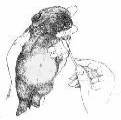
Figure 1
|
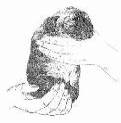 Figure 2 Figure 2 |
2. Head held erect
Using both hands, the pup is held perpendicular to the ground, (straight up), so that its head is directly above its tail. This is an upwards position. Time of stimulation 3 - 5 seconds (Figure 2). |
3. Head pointed down
Holding the pup firmly with both hands the head is reversed and is pointed downward so that it is pointing towards the ground. Time of stimulation 3 - 5 seconds (Figure 3). | 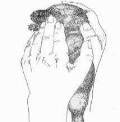
Figure 3
|
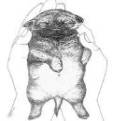
Figure 4
|
4. Supine position
Hold the pup so that its back is resting in the palm of both hands with its muzzle facing the ceiling. The pup while on its back is allowed to sleep/struggle. Time of stimulation 3-5 seconds. (Figure 4) |
5. Thermal stimulation
Use a damp towel that has been cooled in a refrigerator for at least five minutes. Place the pup on the towel, feet down. Do not restrain it from moving. Time of stimulation 3-5 seconds. (Figure 5) | 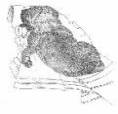 Figure 5 Figure 5 |
Five benefits have been observed in canines that were exposed to the Bio Sensor stimulation exercises. The benefits noted were:
- Improved cardio vascular performance (heart rate)
- Stronger heart beats
- Stronger adrenal glands
- More tolerance to stress
- Greater resistance to disease.
Rule of 7's
By the time a puppy is seven weeks old he/she should have:
- Been on 7 different types of surfaces: carpet, concrete, wood, vinyl, grass, dirt, gravel, wood chips
- Played with 7 different types of objects: big balls, small balls, soft fabric toys, fuzzy toys, squeaky toys, paper or cardboard items, metal items, sticks or hose pieces
- Been in 7 different locations: front yard, back yard, basement, kitchen, car, garage, laundry room, bathroom
- Met and played with 7 new people: include children and older adults, someone walking with a cane or stick, someone in a wheelchair or walker
- Been exposed to 7 challenges: climb on a box, climb off a box, go through a tunnel, climb steps, go down steps, climb over obstacles, play hide and seek, in and out of a doorway with a step up or down, run around a fence
- Eaten from 7 different containers; metal, plastic, cardboard, paper, china, pie plate, frying pan
- Eaten in 7 different locations: crate, yard, kitchen, basement, laundry room, living room, bathroom
Socialization
* Socialization is important so we encourage our friends of all ages, from toddler to elderly, male and female, to visit and play with the puppies.
As the puppies get older Daisy gets to decide when and how often they get to interact with our other dogs. We take our cues from her and after she and the puppies are comfortable interacting with our other dogs we start introducing them to certain friends & family member's (healthy) dogs.
*We take age appropriate "nature hikes" in the woods, car rides and walks in the neighborhood to look at chickens, horses, goats, llamas and cows. All this helps to build Natural Immunity as well as exposing them to many different situations in a safe happy environment.
Weaning
*When the puppies are able to rip meat off the bone and gnaw some bone they are given bone-in chicken. Next is usually pork, turkey and beef, and later lamb and rabbit. Since the pups are from a raw fed mother and I expect no food sensitivities, we add each new protein source every 5-7 days, watching for problems along the way(we have never had a food sensitivity problem). My goal is to have exposed them to all the basic meats they will be eating at their new homes. Exotics can be added as the new owner wishes when they take the puppy home.
*Puppies are provided with fresh clean natural water from our well, starting when weaning begins.
*Worming is done by adding food-grade Diatomaceous Earth to their food daily. See my post on DE here. No chemical wormers will be given to the puppies. Also, No vaccines will be given. Vaccines should not be given before 12- 16 weeks of age, if at all. They have the Mother's immunity and natural Immunity from our frequent outings as I previously discussed as well as immune stimulation from homeopathic nosodes for Distemper & Parvo-virus.
I absolutely will not let a puppy leave before 8 weeks of age and I prefer they be 10-12 weeks old before they leave. This time is critical for your puppy to be with it's mother, litter-mates and pack to learn "bite inhibition" and other social skills, how to be a dog and how to appropriately interact with humans. After they reach an appropriate age you can pick up your puppy. I will give you the earliest date that puppy can be picked up by you when the puppies are born. I can keep your puppy longer if you have scheduling conflicts, or want to wait until a birthday or other important date.
There are tons of "how to" books out there. I recommend any of the books by Cesar Milan, I have had very good results using his principles in training & dealing with my CDs. Here is a link to his book list, he also has DVDs on his website. Cesar Milan Books
Another book I recommend to my puppy families is Brain Work for Smart Dogs by Mogens Eliasen also the K-9 joy website has other books & raw feeding information, as well as a newsletter that is great!
There are tons of "how to" books out there. I recommend any of the books by Cesar Milan, I have had very good results using his principles in training & dealing with my CDs. Here is a link to his book list, he also has DVDs on his website. Cesar Milan Books
Another book I recommend to my puppy families is Brain Work for Smart Dogs by Mogens Eliasen also the K-9 joy website has other books & raw feeding information, as well as a newsletter that is great!
As you can tell, I invest a lot of time and energy into these puppies so they will thrive with "wild health" and will be great companions and ambassadors for the Carolina Dog breed. If you have questions and/or would like to join me on this journey with a wonderful Naturally Reared CD puppy or dog of your own, please contact me via email (susanlewelling@yahoo.com) or phone(865-293-2858) and "Like" us on FaceBook/mycarolinadog. Thanks & I hope to hear from you soon!



We practice Natural Rearing with all of our dogs, They are fed a healthy, balanced, species appropriate and awesome posting blogs.
ReplyDelete